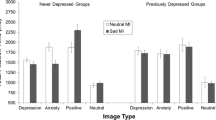Abstract
The eye fixations of 20 dysphoric and 20 nondepressed subjects were recorded as the viewed a series of pictures with both happy and sad regions in order to test the hypothesis that dysphoric subjects would tend to fixate sad themes and that nondepressed subjects would tend to fixate happy themes. It was found that both the dysphoric and the nondepressed fixated happy regions significantly more often, longer, and sooner than they fixated sad regions. It was also found that the dysphoric fixated sad regions significantly more often than did the nondepressed. These results were interpreted as reflecting the operation of a visual attentional defense mechanism, which may work less effectively for the depressed, whose function may be to help the individual avert depression by avoiding negative themes and focusing on positive themes. The impact of negative cognitive biases in this study appeared to be to mitigate the strength of an overall more powerful positive cognitive bias.
Similar content being viewed by others
References
Antes, J. R. (1974). The time course of picture viewing.Journal of Experimental Psychology, 103, 62–70.
Beck, A. T., & Beck, R. W. (1972). Screening depressed patients in family practice: A rapid technique.Postgraduate Medicine, 52, 81–85.
Beck, A. T., Rush, A. J., Shaw, B. F., & Emery, G. (1979).Cognitive therapy of depression. New York: Guilford Press.
Bower, G. H. (1981). Mood and memory.American Psychologist, 36, 129–148.
Burkhart, B. R., Rogers, K., McDonald, W. D., McGrath, R., & Arnoscht, O. (1984). The measurement of depression: Enhancing the predictive validity of the Beck Depression Inventory.Journal of Clinical Psychology, 40, 1368–1372.
Erdelyi, M. H. (1974). A new look at the new Look: Perceptual defense and vigilance.Psychological Review, 81, 1–25.
Gotlib, I. H., & McCann, C. D. (1984). Construct accessibility and depression: An examination of cognitive and affective factors.Journal of Personality and Social Psychology, 47, 427–439.
Kahneman, D. (1973).Attention and effort. Englewood Cliffs, NJ: Prentice-Hall.
Kendall, P. C., Hollon, S. D., Beck, A. T., Hammen, C. L., & Ingram, R. E. (1987). Issues and recommendations regarding use of the Beck Depression Inventory.Cognitive Therapy and Research, 11, 289–299.
Kliegl, R., & Olson, R. (1981). Reduction and calibration of eye monitor data.Behavior Research Methods and Instrumentation, 13, 107–111.
Lowe, D., & Greenbaum, J. (1986, November).Selective attention to negative information in depression: Schemata or criteria? Paper presented at the meeting of the Psychonomic Society, New Orleans.
Mackworth, N. H., & Morandi, A. J. (1967). The gaze selects informative details within a picture.Perception and Psychophysics, 2, 547–552.
MacLeod, C., Mathews, A., & Tata, P. (1986). Attentional bias in emotional disorders.Journal of Abnormal Psychology, 95, 15–20.
Neisser, U. (1976).Cognition and reality. New York: Freeman.
Rayner, K. (1978). Eye movements in reading and information processing.Psychological Bulletin, 85, 618–660.
Author information
Authors and Affiliations
Rights and permissions
About this article
Cite this article
Matthews, G.R., Antes, J.R. Visual attention and depression: Cognitive biases in the eye fixations of the dysphoric and the nondepressed. Cogn Ther Res 16, 359–371 (1992). https://doi.org/10.1007/BF01183287
Issue Date:
DOI: https://doi.org/10.1007/BF01183287




